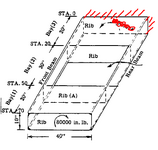At the outset, this question in some fashion is a follow-up of my previous question but I feel is worth asking as a separate one.
Let us say I have a wingbox as shown below subjected to pure torsion at one end and cantilevered at the other. I understand that I can calculate the shear flow as q=T/2A, where A is the enclosed area, which in this case is 40x10. The enclosed area is the same for all the bays and the only load input is the torsion at the free at. Under these conditions:
1. Will the shear flows in the skin/spar vary across the bays if all the bays enclose the same area? If they do vary, what causes the change, and what factors determine this variation?
2. If the shear flows remain constant across the bays, I assume this would indicate that the ribs are not carrying any shear loads. In that case, would removing a rib impact the shear flows at all?
Intuitively, it seems like removing the ribs would reduce the torsional stiffness of the box. However, this feels contradictory if the shear flows don’t vary and the ribs aren’t loaded in shear.
In summary, the question is: Do the ribs play any role if the wingbox (a const. cross-section one) is subjected to pure torsion?

Let us say I have a wingbox as shown below subjected to pure torsion at one end and cantilevered at the other. I understand that I can calculate the shear flow as q=T/2A, where A is the enclosed area, which in this case is 40x10. The enclosed area is the same for all the bays and the only load input is the torsion at the free at. Under these conditions:
1. Will the shear flows in the skin/spar vary across the bays if all the bays enclose the same area? If they do vary, what causes the change, and what factors determine this variation?
2. If the shear flows remain constant across the bays, I assume this would indicate that the ribs are not carrying any shear loads. In that case, would removing a rib impact the shear flows at all?
Intuitively, it seems like removing the ribs would reduce the torsional stiffness of the box. However, this feels contradictory if the shear flows don’t vary and the ribs aren’t loaded in shear.
In summary, the question is: Do the ribs play any role if the wingbox (a const. cross-section one) is subjected to pure torsion?

Last edited:
